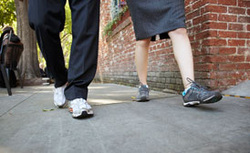|
Two upcoming programs offered by The Jonah Center will explain new plans to increase the walkability and bikeability of Middletown and Portland.
These events include: Bringing the Air Line Trail to Portland When: Tuesday, November 26 from 7-8:30 p.m. Where: Portland Library, Mary Flood Room, 20 Freestone Ave., Portland What: John Shafer, President of the Jonah Center for Earth and Art, and Deanna Rhodes, Planning and Zoning Administrator for the Town of Portland, will describe a proposed extension of the Air Line Trail from East Hampton to Portland. The discussion will include maps, ground level and aerial photographs, cost estimates, potential funding sources, and consideration of the planning and community organizing tasks that will be required to realize this vision. Middletown Street, Sidewalk & Trail Improvements for Walking and Bicycling When: Tuesday, December 3 from 7-8:30 p.m. Where: Russell Library, Hubbard Room, 123 Broad Street, Middletown What: Middletown’s Complete Streets Committee will present specific plans to make city streets and intersections safer and more inviting for bicyclists and pedestrians. This program will include priority areas of Middletown identified by the Master Plan; proposed routes to connect residential neighborhoods to the downtown area, parks, and schools; a new sidewalk along Saybrook Road near the Stop & Shop; proposed improvements in the area of Veterans Park and West Street; Safe Routes to School programs; results of a recent bike-pedestrian traffic count; and state-wide advocacy for biking and walking. Both of these programs are free, open to the public, and no advance registration is necessary. For more contact John Hall at 860-398-3771. The National Center for Safe Routes to School announced that a record number of schools participated in the 2013 Walk to School Day. Schools from all 50 U.S. states, the District of Columbia and Puerto Rico took part, with a total of 4,447 schools pledging to walk to school on October 9th.
According to the National Center for Safe Routes to School, this year’s registration topped 2012’s record total of 4,281. Many more communities celebrated Walk to School Day, but didn’t register their event. Other interesting registration facts:
Check out which schools in Connecticut took part in the event here.  Results from a nationwide survey show that 79% of individuals surveyed know they should be walking more. Additionally, 94% of survey respondents know walking is good for their health. The 2013 Walking Survey also found that 73% of respondents think their children should be walking more. According to the survey, 30% of Americans said they walk more than they did five years ago, 35% are walking less and 32% are walking about the same amount. One third of those surveyed said they don’t walk for 10 minutes at a time over the course of a week. In addition, 31% of those who walk do so for less than 150 minutes per week, which is the minimal threshold for physical activity established by the Centers for Disease Control and Prevention. These are the findings from a survey conducted by GfK on behalf of Kaiser Permanente from Aug. 5 to 13, 2013. Conducted in English and Spanish among 1,224 adults nationwide, the survey sought to take the public’s pulse on walking and the walkability of neighborhoods and communities. “These survey results show that walkable environments are key to encouraging people to walk more,” said Raymond J. Baxter, Ph.D., Kaiser Permanente’s senior vice president for Community Benefit, Research and Health Policy. “The results also reveal the tremendous opportunity we have to build a broad walking movement. By doing so, we will improve the country’s overall health and also forge a deeper connection to the communities where we live, work, learn and play.” Pedestrian Safety According to the survey, the biggest neighborhood barriers to walking include a lack of sidewalks, drivers who speed and drivers who talk on their phones or text. Crime ranks eighth overall out of 15 items, as a neighborhood barrier to walking, but it ranks 5th among both African Americans and Hispanic respondents compared to 12th among white respondents. The importance of neighborhood walkability While six in 10 Americans describe their neighborhood as “walkable,” a majority of Americans do not choose their neighborhood based on its perceived walkability. However, individuals who live in more walkable neighborhoods (with places where it is convenient to walk to services, shopping, schools and jobs) do, in fact, walk more. |
Bike Walk Connecticut
NEWS Send us your bike walk related news and time permitting, we'll do our best to post it.
Topics
All
|
Photo from Roebot
